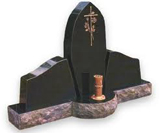 Headstones, graves and tombstones have been used for centuries to mark the place of burial of a deceased person or simply to pay tribute to the memory of a person wherever they may be buried. Such memorials provide a number of different functions which are all equally important and especially important to the close family of the recently departed person. Whoever the person was, whatever their interests and passions were and whatever they achieved is summed up on a simple headstone placed at the site of their grave. Therefore, to pay fitting tribute to the memory of a cherished individual, headstones, graves and tombstones must be respectable and dignified.
Headstones, graves and tombstones have been used for centuries to mark the place of burial of a deceased person or simply to pay tribute to the memory of a person wherever they may be buried. Such memorials provide a number of different functions which are all equally important and especially important to the close family of the recently departed person. Whoever the person was, whatever their interests and passions were and whatever they achieved is summed up on a simple headstone placed at the site of their grave. Therefore, to pay fitting tribute to the memory of a cherished individual, headstones, graves and tombstones must be respectable and dignified.
In tribute to the memory
First and foremost headstones should pay tribute to the memory of the deceased person. They do this by recording vital information about the person such as their name, their date of birth and the date that they died. Further to this, headstones, graves and tombstones often also carry an epitaph written by the immediate family in tribute to the memory of the departed individual. Such an epitaph may contain words of sorrow at the death of the beloved family member or some other heartfelt sentiments. The epitaph should be dignified and respectful and appropriately may tribute to the person’s memory.
In celebration of a life well lived
Although the death of a close loved one is a sad occasion, headstones, graves and tombstones need not be excessively solemn or dreary. The second function of any headstone is to celebrate the life and achievements of the person who has passed away in death. This can be done through the epitaph which can be used to celebrate the person and their achievements rather than focus on the fact that the person has passed away.
When a family loses a cherished love one, they can view the erection of headstones, graves and tombstones in one of two ways. They can view the headstone as a solemn memorial to the death of someone who was dear to them or they can view the headstone as a celebration of a life well lived. In whatever light the headstone is viewed it is of great importance to keep the memory of the deceased loved one alive and ensure that they are never forgotten for generations to come.
Headstones, graves and tombstones enable the surviving family members to have a focal point for their mourning. They allow relatives to visit the gravesite of the loved one and view a dignified and respectful memorial to the cherished individual. This allows them to spend time in the peace and quiet and reflect on the memory of the deceased person without the distractions of the world around them. Spending time at the gravesite also provides a great feeling of closeness with the departed loved one. Whatever the purpose of the memorial, headstones, graves and tombstones serve a vital purpose in keeping the memory of the loved one alive and paying tribute to their life.
